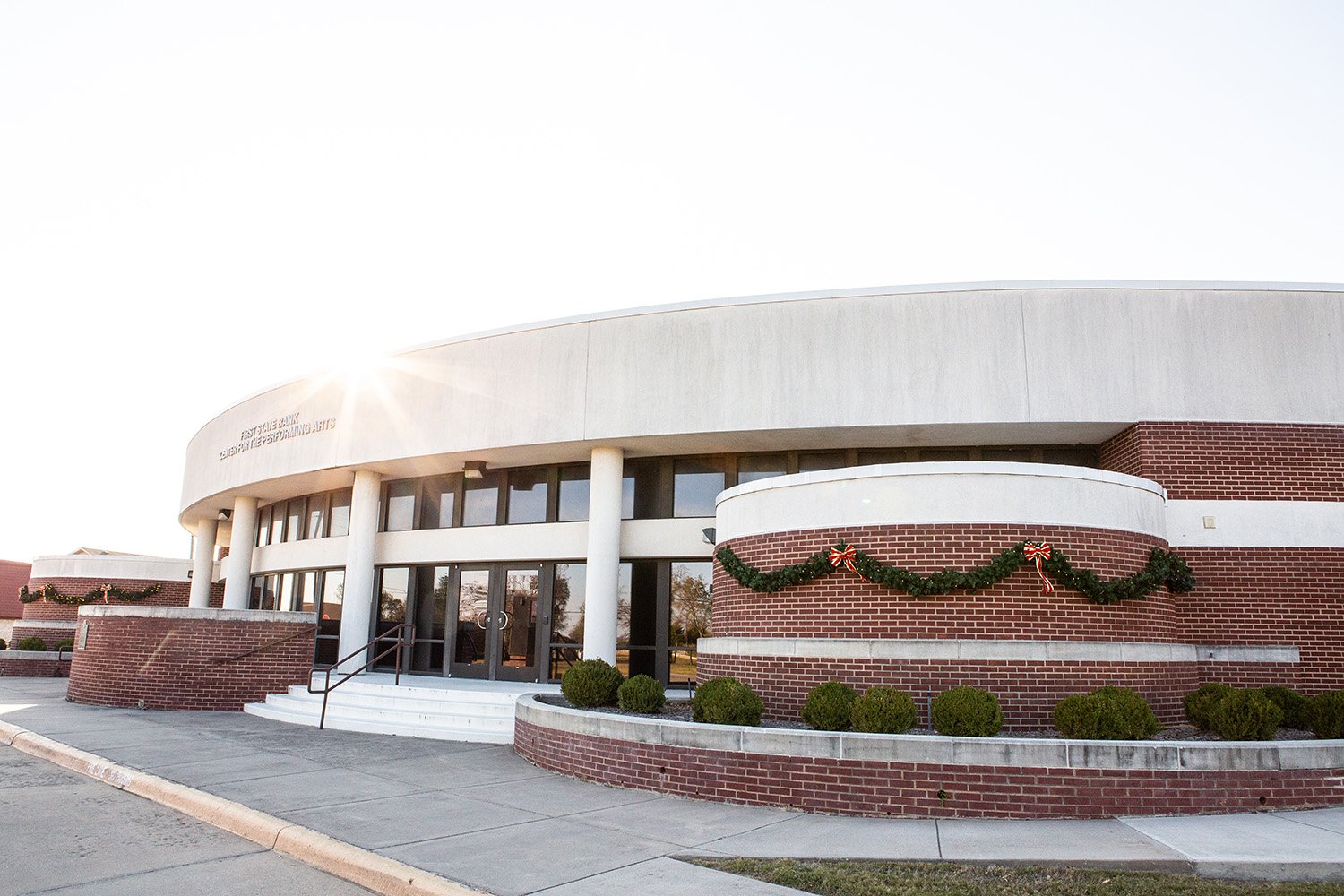
First State Bank Center for the Performing Arts
We would like to continue to thank First State Bank for sponsoring the Performing Arts at North Central Texas College.
> PROGRAMS > PERFORMING ARTS > FIRST STATE BANK CENTER FOR PERFORMING ARTS
The History of an Opportunity to Learn in a State-of-the-Art Facility
The unique monolithic dome-based design of the new First State Bank Center for the Performing Arts at North Central Texas College, makes it a distinctive landmark structure for both the Gainesville Campus and the local community. But it's what goes on inside the building that is generating the most excitement among college faculty and staff, both current and prospective students and local musicians, singers, actors and patrons of the arts.
Event Calendar
See the calendar below for a list of events happening in the First State Bank Center for the Performing Arts on the NCTC Gainesville Campus.
“Finally, with quality facilities for the teaching of both the performing and visual arts in place, our campus can truly become the cultural center of the community.”
— Dr. Eddie Hadlock, former NCTC Interim President
A Modern Facility
The Interior & Exterior of the Center for Performing Arts
Long before the architect began his work in earnest and even longer before ground was broken for the FSB Center for the Performing Arts at NCTC, program faculty members and college staff worked for many months to help visualize and refine the building's design. Having gone many decades without adequate facilities to house the performing arts, they wanted to be sure they got it right! Now that the facility is finally a reality, reactions from audiences and performers alike indicate that's exactly what they did.
"We're so excited about this building, and we hope prospective students in drama, music, and dance will be excited, too.” — Gabrielle Fletcher, Fine Arts Department Chair
Having experienced the facility as audience member, administrator, and performer (she formerly played with the NCTC Jazz Band), Fletcher believes the new FSB Center for the Performing Arts will play a central role in building something that is much more important than a building.
"We are committed to building a program in the performing arts that is known throughout the region for true excellence. We have an outstanding faculty, and now we have the facility, so we are well on our way. I'm getting more and more calls every day from prospective students who want to be a part of what we're trying to establish here." — Gabrielle Fletcher, Fine Arts Department Chair
Space by Space
-
The performance space in the FSBCPA has a seating capacity of 360 - a number carefully chosen to maintain a measure of intimacy and to bring the audience as close to the performers as possible. Extensive research by college staff and consultation with a variety of experts revealed that a seating capacity in this range or even smaller is the most prevalent among university and civic theatres and performance venues which serve both theatre and music programs.
"This is not intended to be an 'auditorium' in the conventional sense," said Fletcher, "nor is it intended to be a 'multi-purpose' meeting center or anything else other than what it is expressly designed to be - a quality teaching and learning facility, first and foremost, that incorporates a state-of-the-art performance space in which students can apply and showcase their knowledge, skills, and talents in actual plays, concerts, and so on. Back row seats in the rear of the house will be only about 50 feet from the front of the stage.”
"The seats will be large, comfortable, and set at a 'raked' angle to enhance sight lines, and they will be arranged in a 'continental' pattern which has no center aisles but rather has extra wide spaces between rows. There will not be a bad seat in the house."
-
The stage, with a 42-foot proscenium opening, is large enough to accommodate just about any type of production, even a concert featuring a full chorale and symphony. There is also a fully functional fly loft with a counterweight fly rigging system for both scenery and lighting, as well as something stage and musical directors can never get enough of - lots and lots of offstage and wing space to accommodate scenery, set pieces, orchestra shells, and of course, backstage crew members and performers waiting to make their entrance. The following views show the spaciousness and versatility of the stage. Note the semi-circular, motorized main drape, seen from backstage, in View 1. View 2, View 3, and View 4 show the fly rail, entrance to Scenery shop from offstage and ample offstage storage space. View 5 and View 6 show how great this space is for performers and technicians alike. Look closely at the stage floor in View 6 on the downstage side of the piano - you'll see the outline of our 36-foot "turntable" or revolving section.
-
For musicals, there is a large orchestra pit in front of the stage which can be covered and converted to extended stage space when not in use. For performances, the pit can easily accommodate up to 30 musicians.
-
Topping off the list of production-related amenities is a large, fully outfitted scenery shop, costume storage room and large, well-appointed dressing rooms for both men and women. There will even be a "green room," a traditional theater and performing hall term for the space in which performers congregate prior to and during performances when not on stage. The space will double as instructional space.
Floorplan
"Because this will be a fully functional instructional facility," said Dr. Hadlock, "the building also will feature classrooms and laboratory space for students enrolled in both theatre and music courses."
He said these include large rehearsal halls for the NCTC Singers and choir as well as the Jazz Band and other instrument ensembles. In addition there will be sound-proofed practice rooms, a computer lab for music theory and composition, and storage rooms for instruments, sheet music, and other supplies.
College officials stressed that while the facility's primary purpose is to house instructional programs in the performing arts, there are definitely plans in the works to collaborate and forge partnerships with various community-based organizations.
"By collaborating with organizations such as Butterfield Stage Players," Dr. Hadlock explained, "we will be establishing important linkages with the community NCTC serves, but the primary and most significant value of these partnerships goes far beyond that. For the college, mounting joint productions in collaboration with the local community theatre group, for example, will give our student actors, designers, and technicians the opportunity to be directly involved in up to five major shows per academic year as opposed to only one per semester."
Dr. Hadlock added that this broadens and enriches the learning experience NCTC is able to provide students in a very significant and positive way. At the same time, he said, it also broadens and enriches the talent pool for community partners, provides them access to quality facilities, and vastly increases the quality and scope of productions to be enjoyed by local audiences.
Monolithic Dome Design Makes the Building Unique
The FSB Center for the Performing Arts may be the first monolithic dome in the entire country designed and built specifically for this purpose. Fort Worth's Casa Manana, for example, is a "geodesic" dome and a much different type of building, containing not only a performance space but also classrooms, labs, rehearsal and practice rooms, scene shop and other features.
"While monolithic domes are certainly nothing new, we don't know of any others that were expressly designed from the ground up to house a performing arts center or theater - on a college campus or anywhere else." — Dr. Steve Broyles, NCTC Dean of Administrative Services
The project architect was Rick Crandall of Crandall Design Group, the Mesa, AZ, firm which did the preliminary designs for the project and which specializes in the design of monolithic domes. Crandall, whose personal residence is a monolithic dome, said these unique types of structures are not only less expensive to construct than more conventional building types but also stronger, more durable and considerably more energy efficient.
"Those are big reasons why the popularity of monolithic domes is growing so rapidly. More and more, public and private school buildings, churches, office buildings, homes, sports arenas and gymnasiums, even manufacturing plants are being built as monolithic domes. They're amazingly flexible and adaptable to so many different kinds of uses." — Dr. Steve Broyles, NCTC Dean of Administrative Services
The process used to erect monolithic domes is as interesting and unique as the structures themselves. After site preparation, the first step is the laying of a perimeter foundation "ring" of reinforced concrete.Vertical steel bars embedded in the ring beam footing are later attached to the steel reinforcing of the dome itself.
Next, an "airform" or flexible membrane, fabricated to a proper shape and size, is attached to the concrete base. Using fans, this membrane is inflated-creating the shape of the dome. Then, approximately three inches of polyurethane foam insulation is applied to the interior surface.
Steel reinforcing bars, specially engineered and arranged in a precise criss-cross pattern, are attached to the foam using special "hooks" embedded in the foam. The final step is the spraying of several inches of a special mix of concrete onto the interior surface of the polyurethane foam, embedding the rebar.
"The resulting steel-reinforced concrete dome structure can literally withstand a tornado. The inside of the dome is so strong structurally that you could probably hang an18-wheeler from the ceiling." — Rick Crandall, Architect of Crandall Design Group, the Mesa, AZ.
Crandall said he has designed many domes, but he is particularly excited about this one.
"I feel sure the folks at NCTC are going to be hosting quite a few visitors from all over the country wanting to see how ideal this type of building is for a performing arts facility." — Rick Crandall, Architect of Crandall Design Group, the Mesa, AZ.
Accepting the gift, left to right, are Dr. Eddie Hadlock, interim president, Dr. Milton Dickson, regent who was serving as chairman of the board when the project was begun, and Russell Duncan, former Board of Regents chair.
First State Bank Donation
Facility Named in Recognition of Generous Gift
Frank Morris, left, chairman of First State Bank, presents a check for $150,000 to NCTC officials in support of the new Center for the Performing Arts. In recognition of the donation, NCTC's Board of Regents voted to name the facility the First State Bank Center for the Performing Arts. The bank's gift also is recognized on the custom donor wall adjacent to the CPA Box Office.



